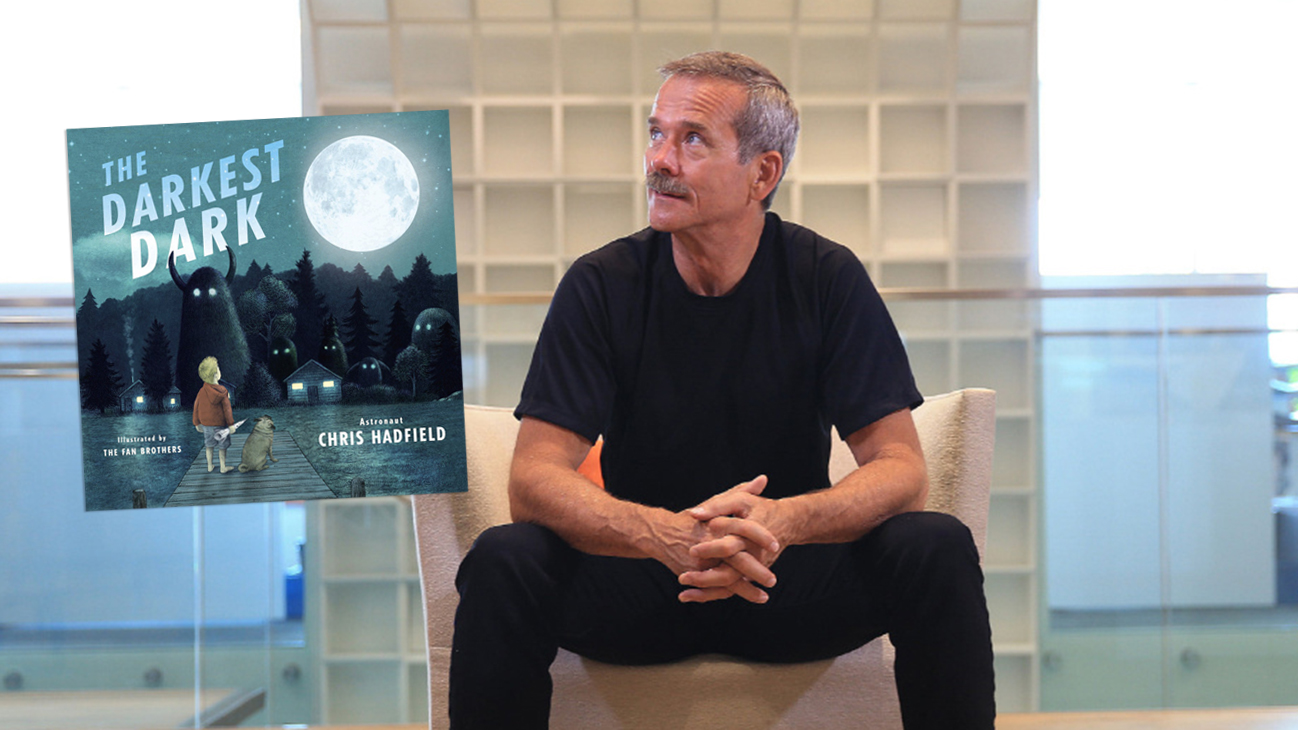Chris Hadfield can walk in space, fly a plane, write books and perform David Bowie songs in microgravity. But when he was a kid, he couldn’t sleep. In The Darkest Dark, his semi-autobiographical children’s book, Hadfield details his crippling fear of the dark, which presented itself during nighttimes at his family cottage on Stag Island, near Sarnia, Ont., where the book is set.
Despite his parents’ creative attempts to assuage young Hadfield’s fears — they gave him a bell to ring if he got nervous — it wasn’t until the already-aspiring astronaut watched the Apollo 11 moon landing that his feelings toward bedroom shadows and inky skies began to change.
“He’d seen that the darkness of the universe was so much bigger and deeper than the darkness in his room, but he was not afraid. He wanted to explore every corner of the night sky,” he writes in the book. “For the first time, Chris could see the power and mystery and velvety black beauty of the dark.”
The Darkest Dark was written in collaboration with Toronto journalist Kate Fillion and features illustrations by Toronto brothers Terry and Eric Fan. It is meant for children ages 3 to 7 and is available for sale in Canada Sept. 10.
The Star spoke with Hadfield, 56, about overcoming fears, summers on Stag Island and why space travel isn’t scary . . . even though it can be dark.
Why a book for children?
You can’t fly in space forever — the medical’s too hard to pass. So what do we do next? (My wife) and I made a list of the things that give us a sense of worth in life: teaching, feeling like you’re contributing, being a good citizen, variety, challenging yourself, writing, music. The reason is all connected to pretty much everything that my wife and I were talking about eight years ago — and that is, what do you do with this experience? I’m 56 and I have to be doing stuff. Why not try and share the experience that I’ve been privileged enough to enjoy?
The Fan brothers visited your parents’ cottage. Was it important to keep it authentic?
Why not? The story is semi-autobiographical. It’s a real place. That is very much my parents’ cottage. This place formed who I am so why would you not base it in that reality?
When you say the place formed you, what do you mean?
We’re all somewhat the products of the influences that were around us when we were little. Stag Island is in the St. Clair River. It’s privately owned by the cottagers. There are no vehicles on the island, just bicycles. There are 100 cottages. It’s got these huge ancient oaks as well as pines. It’s kind of a weird, lovely refuge that is very grounding in my life. It’s one of the few places on earth where I completely feel at home and relaxed. To go there is to exhale. I’ve been going to this cottage since I was 2. For me, it’s helped me establish what normal is.
How much time did you spend at the cottage growing up?
Every summer, all summer.
When you became an astronaut, was it ever scary being in space?
Scary? No. Scary means an unanticipated event that I’m not ready to deal with. Scary is in the eyes of the beholder. Driving a car. You put a 14-year-old in a car and they’re terrified. But 10 years later, it’s not scary at all because they have learned the difference between danger and fear. (Space travel) was hugely challenging and complex and fascinating and demanding and relentless and hard, but not scary.
What do you hope kids take away of this?
That it’s OK to be afraid. But that there’s a difference between being afraid and choosing what you’re going to do about that. Just because you’re afraid doesn’t mean that you should exclude whatever you’re afraid of from the rest of your life. You should try and look at, “Why am I afraid?”
Don’t let fear be a security blanket that allows you to deny yourself most of the great experiences of life.

